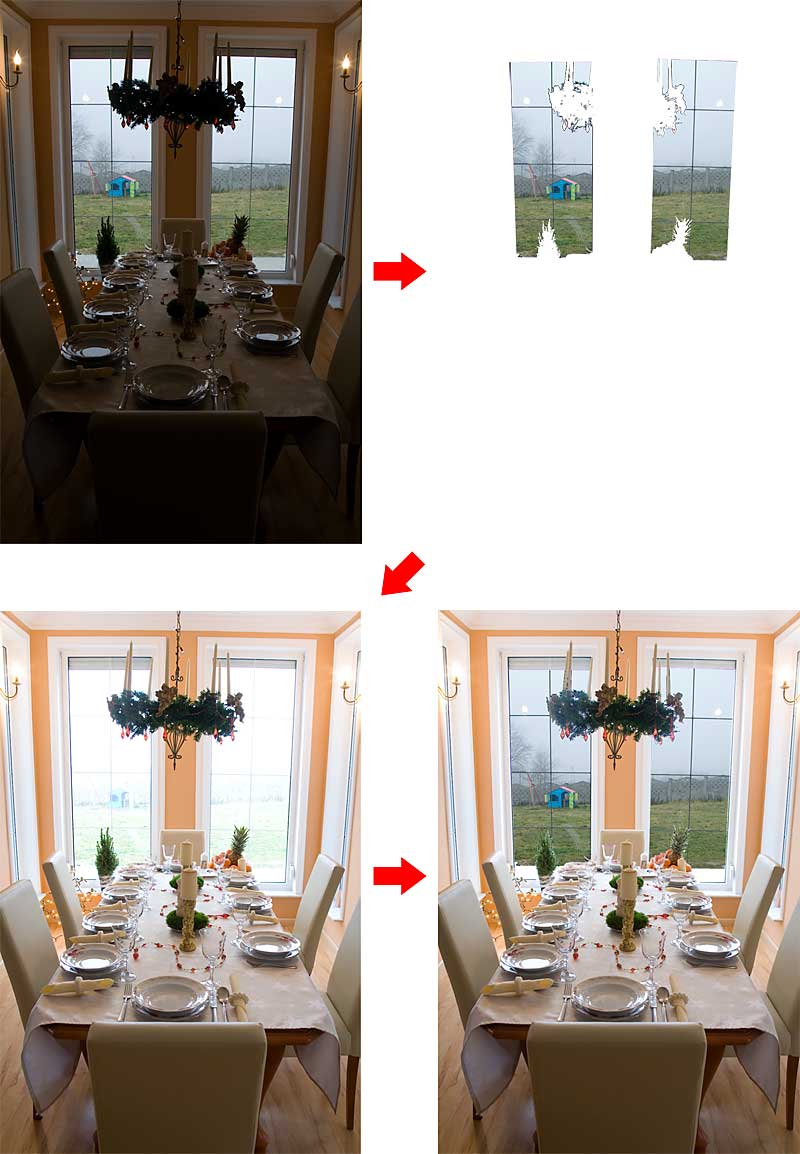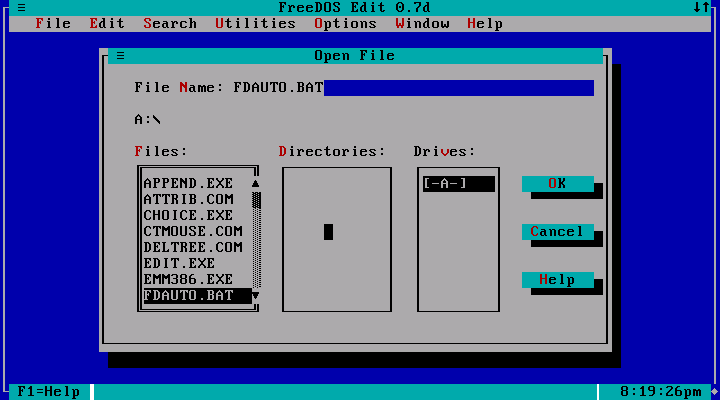|
Enfuse
Enblend-Enfuse are open source console application created by Andrew Mihal and mostly maintained by Hugin developers. It consists of Enblend, an image blending tool useful for creating panoramas, and Enfuse, an exposure fusion (HDR merging) and focus stacking tool that combines the depth of field and dynamic range from multiple images of the same scene (bracketing). Enblend-enfuse accepts images already aligned by other methods. Technique Enblend uses the Burt-Adelson spline for blending. Enfuse uses the Mertens-Kautz-Van Reeth (MKVr) approach to exposure fusion, which does not require reconstructing an HDR intermediate. The MKVr approach involves blending images by quality estimates based on contrast, saturation, and well-exposedness. Enblend extends the estimate with a fourth term of information entropy In information theory, the entropy of a random variable is the average level of "information", "surprise", or "uncertainty" inherent to the variable's possible outcomes ... [...More Info...] [...Related Items...] OR: [Wikipedia] [Google] [Baidu] |
Hugin (software)
Hugin () is a cross-platform open source panorama photo stitching and HDR merging program developed by Pablo d'Angelo and others. It is a GUI front-end for Helmut Dersch's Panorama Tools and Andrew Mihal's '' Enblend'' and ''Enfuse''. Stitching is accomplished by using several overlapping photos taken from the same location, and using control points to align and transform the photos so that they can be blended together to form a larger image. Hugin allows for the easy (optionally automatic) creation of control points between two images, optimization of the image transforms along with a preview window so the user can see whether the panorama is acceptable. Once the preview is correct, the panorama can be fully stitched, transformed and saved in a standard image format. Features Hugin and the associated tools can be used to * combine overlapping images for panoramic photography * correct complete panorama images, e.g. those that are "wavy" due to a badly levelled panoramic camera ... [...More Info...] [...Related Items...] OR: [Wikipedia] [Google] [Baidu] |
Exposure Fusion
In image processing, computer graphics, and photography, exposure fusion is a technique for blending multiple exposures of the same scene (bracketing) into a single image. As in high dynamic range imaging (HDRI or just HDR), the goal is to capture a scene with a higher dynamic range than the camera is capable of capturing with a single exposure. Technique By using different exposure parameters on the same scene, a wider dynamic range can be represented and later merged into an image with better dynamic range. After correcting for small shifts that may inadvertently happen with hand-held devices, the full-image can be fused in two ways: * A higher dynamic range raw image can be reassembled and tone-mapped like usual HDR images, or more commonly: * A blended image can be directly produced without reconstructing a higher bit-depth. The former method assumes a linear response from the camera, which may be provided by DNG or other raw formats. Some variants can take developed im ... [...More Info...] [...Related Items...] OR: [Wikipedia] [Google] [Baidu] |
Focus Stacking
Focus stacking (also known as focal plane merging and z-stacking or focus blending) is a digital image processing technique which combines multiple images taken at different focus distances to give a resulting image with a greater depth of field (DOF) than any of the individual source images. Focus stacking can be used in any situation where individual images have a very shallow depth of field; macro photography and optical microscopy are two typical examples. Focus stacking can also be useful in landscape photography. Focus stacking offers flexibility: since it is a computational technique, images with several different depths of field can be generated in post-processing and compared for best artistic merit or scientific clarity. Focus stacking also allows generation of images physically impossible with normal imaging equipment; images with nonplanar focus regions can be generated. Alternative techniques for generating images with increased or flexible depth of field incl ... [...More Info...] [...Related Items...] OR: [Wikipedia] [Google] [Baidu] |
Cross-platform
In computing, cross-platform software (also called multi-platform software, platform-agnostic software, or platform-independent software) is computer software that is designed to work in several computing platforms. Some cross-platform software requires a separate build for each platform, but some can be directly run on any platform without special preparation, being written in an interpreted language or compiled to portable bytecode for which the interpreters or run-time packages are common or standard components of all supported platforms. For example, a cross-platform application may run on Microsoft Windows, Linux, and macOS. Cross-platform software may run on many platforms, or as few as two. Some frameworks for cross-platform development are Codename One, Kivy, Qt, Flutter, NativeScript, Xamarin, Phonegap, Ionic, and React Native. Platforms ''Platform'' can refer to the type of processor (CPU) or other hardware on which an operating system (OS) or applicatio ... [...More Info...] [...Related Items...] OR: [Wikipedia] [Google] [Baidu] |
GNU GPL
The GNU General Public License (GNU GPL or simply GPL) is a series of widely used free software licenses that guarantee end users the four freedoms to run, study, share, and modify the software. The license was the first copyleft for general use and was originally written by the founder of the Free Software Foundation (FSF), Richard Stallman, for the GNU Project. The license grants the recipients of a computer program the rights of the Free Software Definition. These GPL series are all copyleft licenses, which means that any derivative work must be distributed under the same or equivalent license terms. It is more restrictive than the Lesser General Public License and even further distinct from the more widely used permissive software licenses BSD, MIT, and Apache. Historically, the GPL license family has been one of the most popular software licenses in the free and open-source software domain. Prominent free software programs licensed under the GPL include the Linux ... [...More Info...] [...Related Items...] OR: [Wikipedia] [Google] [Baidu] |
Open Source
Open source is source code that is made freely available for possible modification and redistribution. Products include permission to use the source code, design documents, or content of the product. The open-source model is a decentralized software development model that encourages open collaboration. A main principle of open-source software development is peer production, with products such as source code, blueprints, and documentation freely available to the public. The open-source movement in software began as a response to the limitations of proprietary code. The model is used for projects such as in open-source appropriate technology, and open-source drug discovery. Open source promotes universal access via an open-source or free license to a product's design or blueprint, and universal redistribution of that design or blueprint. Before the phrase ''open source'' became widely adopted, developers and producers have used a variety of other terms. ''Open source'' gai ... [...More Info...] [...Related Items...] OR: [Wikipedia] [Google] [Baidu] |
Console Application
A console application is a computer program designed to be used via a text-only computer interface, such as a text terminal, the command-line interface of some operating systems (Unix, DOS, etc.) or the text-based interface included with most graphical user interface (GUI) operating systems, such as the Windows Console in Microsoft Windows, the Terminal in macOS, and xterm in Unix. Overview A user typically interacts with a console application using only a keyboard and display screen, as opposed to GUI applications, which normally require the use of a mouse or other pointing device. Many console applications such as command line interpreters are command line tools, but numerous text-based user interface (TUI) programs also exist. As the speed and ease-of-use of GUIs applications have improved over time, the use of console applications has greatly diminished, but not disappeared. Some users simply prefer console based applications, while some organizations still rely ... [...More Info...] [...Related Items...] OR: [Wikipedia] [Google] [Baidu] |
Image Stitching
Image stitching or photo stitching is the process of combining multiple photographic images with overlapping fields of view to produce a segmented panorama or high-resolution image. Commonly performed through the use of computer software, most approaches to image stitching require nearly exact overlaps between images and identical exposures to produce seamless results, although some stitching algorithms actually benefit from differently exposed images by doing high-dynamic-range imaging in regions of overlap. Some digital cameras can stitch their photos internally. Applications Image stitching is widely used in modern applications, such as the following: *Document mosaicing * Image stabilization feature in camcorders that use frame-rate image alignment *High-resolution photomosaics in digital maps and satellite imagery * Medical imaging *Multiple-image super-resolution imaging *Video stitching *Object insertion Process The image stitching process can be divided into three m ... [...More Info...] [...Related Items...] OR: [Wikipedia] [Google] [Baidu] |
Panorama
A panorama (formed from Greek πᾶν "all" + ὅραμα "view") is any wide-angle view or representation of a physical space, whether in painting, drawing, photography, film, seismic images, or 3D modeling. The word was originally coined in the 18th century by the English (Irish descent) painter Robert Barker to describe his panoramic paintings of Edinburgh and London. The motion-picture term ''panning'' is derived from ''panorama''. A panoramic view is also purposed for multimedia, cross-scale applications to an outline overview (from a distance) along and across repositories. This so-called "cognitive panorama" is a panoramic view over, and a combination of, cognitive spaces used to capture the larger scale. History The device of the panorama existed in painting, particularly in murals, as early as 20 A.D., in those found in Pompeii, as a means of generating an immersive " panoptic" experience of a vista. Cartographic experiments during the Enlightenment era p ... [...More Info...] [...Related Items...] OR: [Wikipedia] [Google] [Baidu] |
Bracketing
In photography, bracketing is the general technique of taking several shots of the same subject using different camera settings. Bracketing is useful and often recommended in situations that make it difficult to obtain a satisfactory image with a single shot, especially when a small variation in exposure parameters has a comparatively large effect on the resulting image. Given the time it takes to accomplish multiple shots, it is typically, but not always, used for static subjects. Autobracketing is a feature of many modern cameras. When set, it will automatically take several bracketed shots, rather than the photographer altering the settings by hand between each shot. Types of bracketing Exposure bracketing Image:StLouisArchMultExpEV-4.72.JPG, –4 stops Image:StLouisArchMultExpEV-1.82.JPG, –2 stops Image:StLouisArchMultExpEV+1.51.JPG, +2 stops Image:StLouisArchMultExpEV+4.09.JPG, +4 stops Without further qualifications, the term ''bracketing'' usually refers to exposu ... [...More Info...] [...Related Items...] OR: [Wikipedia] [Google] [Baidu] |
Information Entropy
In information theory, the entropy of a random variable is the average level of "information", "surprise", or "uncertainty" inherent to the variable's possible outcomes. Given a discrete random variable X, which takes values in the alphabet \mathcal and is distributed according to p: \mathcal\to, 1/math>: \Eta(X) := -\sum_ p(x) \log p(x) = \mathbb \log p(X), where \Sigma denotes the sum over the variable's possible values. The choice of base for \log, the logarithm, varies for different applications. Base 2 gives the unit of bits (or " shannons"), while base ''e'' gives "natural units" nat, and base 10 gives units of "dits", "bans", or " hartleys". An equivalent definition of entropy is the expected value of the self-information of a variable. The concept of information entropy was introduced by Claude Shannon in his 1948 paper " A Mathematical Theory of Communication",PDF archived froherePDF archived frohere and is also referred to as Shannon entropy. Shannon's theory ... [...More Info...] [...Related Items...] OR: [Wikipedia] [Google] [Baidu] |
Free Software
Free software or libre software is computer software distributed under terms that allow users to run the software for any purpose as well as to study, change, and distribute it and any adapted versions. Free software is a matter of liberty, not price; all users are legally free to do what they want with their copies of a free software (including profiting from them) regardless of how much is paid to obtain the program.Selling Free Software (gnu.org) Computer programs are deemed "free" if they give end-users (not just the developer) ultimate control over the software and, subsequently, over their devices. The right to study and modify a computer program entails that source code< ... [...More Info...] [...Related Items...] OR: [Wikipedia] [Google] [Baidu] |








